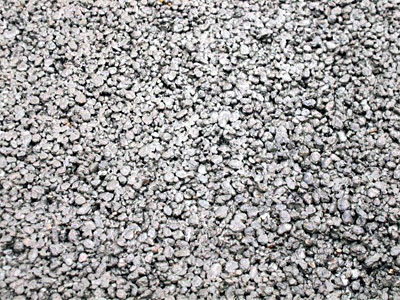Benefits
Structural Benefits
Benefits | Attractive | Economic | Environmental | Structural | LEED
Textured Surface
Pervious concrete, lacking the fine aggregates of conventional concrete, has a unique surface texture. Made up primarily of rounded and angular aggregates such as gravel and crushed stone, it has an appearance similar to that of a Rice-Krispie treat. The exposed course aggregates of pervious concrete provide enhanced traction for vehicles and prevent driving hazards such as hydroplaning. The textured surface is especially beneficial during the most difficult and dangerous of driving conditions, such as in rain and snow.
Void Structure
 The permeability of pervious concrete provides increased safety for drivers. When used instead of impervious asphalt as a parking area pavement, pervious concrete substantially improves driving safety during wet weather conditions. Rain seeps down through the concrete rather than remaining on the surface, which eliminates the spraying and pooling of water. This subsequently reduces night-time glare for the driver and lessens the risk of hydroplaning. Anecdotal evidence also suggests that snow-covered pervious concrete clears more quickly than other pavements, as its voids allow for more rapid thawing.
The permeability of pervious concrete provides increased safety for drivers. When used instead of impervious asphalt as a parking area pavement, pervious concrete substantially improves driving safety during wet weather conditions. Rain seeps down through the concrete rather than remaining on the surface, which eliminates the spraying and pooling of water. This subsequently reduces night-time glare for the driver and lessens the risk of hydroplaning. Anecdotal evidence also suggests that snow-covered pervious concrete clears more quickly than other pavements, as its voids allow for more rapid thawing.
After a rainfall, there is a significant visible difference between pervious concrete and asphalt pavements. While asphalt stays slick with rainwater, pervious surfaces are more likely to remain unaltered by the weather. Click here to view pervious and asphalt comparison photos and see for yourself!
Strength and Durability
Pervious concrete is a strong and highly durable material. Parking areas properly designed and constructed will last 20-40 years with little or no maintenance. Unlike asphalt, surface raveling (the loosening of surface aggregates) is common only in the first few weeks after the concrete is laid, and it can be reduced with proper compaction and curing techniques.
Pervious concrete mixes contain minimal amounts of water and therefore have very low slump (i.e. a stiff consistency). A much smaller amount of drying shrinkage occurs in the placement of pervious concrete than dense, and it develops sooner, as well. This allows many pervious pavements to be constructed without crack-preventing control joints. Random cracks that do form are not abundant, and they have no significant impact on the structural integrity of the pavement. They also generally do not detract aesthetically from the concrete's appearance.
Pervious pavements can achieve strengths in excess of 3000 psi (strong enough to support a fire truck), and even more with special mix designs, structural designs, and placement techniques. The key to high-performance concrete is the use of supplementary cementitious materials such as silica fume, fly ash, and blast furnace slag, all which increase durability by decreasing permeability and cracking. Concrete strength can also be maximized by installing subgrade and subbase levels of course and/or fine aggregates beneath the pavement.


